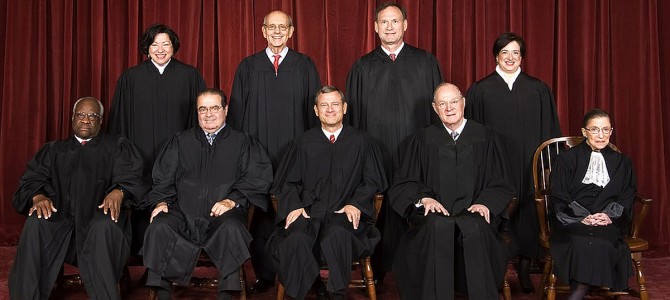
As expected, President Obama has appointed a supposedly “moderate” and “centrist” nominee for the Supreme Court, which is code for someone with a thin enough record of actual ideas and convictions that nobody can really tell how he would rule on anything.
Clearly, Obama is hoping to shame Senate Republicans into confirming his nominee. The idea is to pick someone so unobjectionable that refusing to take up his appointment will seem to be motivated by mere partisan hatred for Obama. And as we all know, partisanship is really bad—when the other side does it.
This approach can be dealt with easily enough, if Senate Republicans want to. I laid out the approach a few months ago.
If Obama nominates a ‘living constitution’ type, they can reject him for being a big-government leftist. If Obama nominates a muddled, middle-of-the-road moderate, they can reject him for having no firm principles. If Obama nominates someone with a record so scrubbed clean of stated ideas and difficult decisions that nobody has any idea how he will rule on anything, they can reject him for being a mystery man.
The fact that you can find analyses placing Obama’s nominee in all three categories indicates that he probably belongs in the third category.
But there is a wider principle at work here. If we understand the history of Supreme Court appointments over the past half-century or so—basically, since FDR swept out the last of the Lochner-era justices—we can understand that there is really no such thing as a “moderate” Supreme Court nominee.
Last year, I listed two basic rules for how Supreme Court appointments turn out.
First, doubt about how the court will rule is almost always doubt about how the Republican-appointed ‘conservative’ justices will rule. There is rarely any debate over how the four Democrat-appointed ‘liberals’ will decide, because they consistently rule in line with partisan political requirements.
We saw this in the initial oral hearings on Obamacare and individual mandate. Even though Justice John Roberts would eventually switch sides, what was important was the fact that the five conservative justices heard an argument for constitutional limits on government power over the economy, and they took it seriously. The left-leaning commentariat responded with total shock, as if such a thing were unimaginable. And for the court’s “liberal” justices, it was.
That leads us to the second rule:
Republican appointees sometimes move left, but somehow Democratic appointees never move right. If you count Roberts, Kennedy, and the now retired David Souter, about half of the Republican appointees became very unreliable conservative votes, to say the least. That’s a defection rate of about half over the past thirty years…. But where is the Democratic appointee who has suddenly discovered the virtues of limited government and property rights? It’s almost as if only one side is uniformly politically dogmatic.
Which is to say that there is such a thing as a “moderate” Supreme Court justice, who votes sometimes with one side and sometimes with another. But the only such “moderates” on the Court right now are Republican-appointed “conservative” justices.
It is a mistake to assume that the status quo on the Supreme Court, before Justice Scalia’s death, was a 5-4 conservative majority. In practice, it was more like a 4-4 conservative/liberal standoff, with a lot of the important cases being decided by a single swing vote—and Justices Kennedy and Roberts alternating in that role.
Does the Clear Air Act give the Environmental Protection Agency unlimited power to regulate any emissions of anything? Justice Kennedy swings over to the left. Does the Second Amendment protect the right to own guns? Kennedy swings back to the right. Can the provisions of Obamacare be rewritten at the will of the executive in order to make the law work? Roberts acts as the swing vote toward the liberal side on that issue, twice. Does the Constitution mandate gay marriage? Kennedy goes back left again. And so on.
The reason why “liberal” justices decide cases en bloc and conservative justices move left has less to do with a specific interpretation of the Constitution than it has to do with the failure of constitutionalism. They fail to grasp the idea of the Constitution as a restriction on government power, particularly not in the areas—business, commerce, and capitalism—where they’ve become accustomed to regarding unlimited government power as the norm.
The death of constitutionalism on the left—and its parlous state even among “conservative” justices—has clear implications for the current battle. The upshot for Senate Republicans is that they need to reject this nominee and anyone else President Obama is remotely likely to put forward. But this has even bigger implications for the remaining Republican primaries. As I wrote before, the upshot of the rules of Supreme Court appointments is:
We can no longer be taken in by the ideal of a judge as a neutral guardian of process, held back by ‘judicial restraint.’ Instead, we will have to expect that the next Republican president appoint someone with a proven track record as a warrior for our cause. And as with just about everything that has happened over the past century, this increases the power of the presidency and the stakes for the party that captures it.
This year, I should add: it also increases the stakes for the faction of the party that captures the nomination.
Follow Robert on Twitter.









